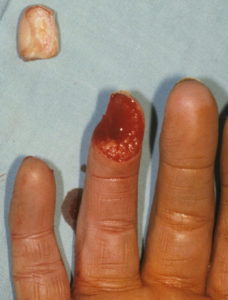As Vinay held his hand up high, he could feel the sharp blade slice through his index finger and the outer part of his wrist. Blood came gushing onto the ground, and his index finger dropped clean right in front of him. Vinay was trying to defend himself from the attack. Three unknown assailants armed with ‘aruvaals’ (machete-like weapons) attempted to rob him in broad daylight. As he defended himself to ward off the attack, he sustained a deep laceration wound over the outer part of his hand and his index finger was amputated.

Picture source: ScienceDirect
The scenario above sounds like one out of a typical Kollywood movie but the injury is as real as it gets. Digital or finger amputation is a common injury seen in most orthopedic centers around our country. Amputation of the finger can occur due to a crush injury, tearing or avulsion of the finger or as poor Vinay suffered – a clean cut by a weapon or a sharp tool. Injury to the finger can occur at any level, the tip usually being the common site as it is the last part of the finger to escape harm’s way. Finger amputation occurs when the finger is no longer in contact with the rest of the hand, while the term near-total amputation in describes a finger which is almost detached except for some soft tissue attachments.
For a patient who has sustained a finger amputation, it is important to follow some key points to improve survival of the severed part. Preferably the amputated part is washed with water or better still with sterile saline solution and wrapped with a moist clean gauze. The gauze with the severed part is then put into a clean bag, which in turn is put into another clean bag containing ice cubes. It is crucial to avoid direct contact of the amputated part with ice as this would likely damage the tissue further. The patient and the amputated tip should be brought to the nearest hospital as soon as possible to improve outcome of surgery. The site of injury over the hand should also be attended to. The injured part is cleaned and covered with moist saline to prevent contamination and reduce bleeding by applying some compression. The injured hand should be held up to reduce bleeding and not left hanging down.
Replantation is the term describing the attachment of the finger back to its site of origin. An amputated finger can only be replanted surgically and this is an extremely meticulous task and is one of the more highly specialized surgeries ever to be performed. At present, only several tertiary hospitals in the country have both facilities as well as expertise for this kind of surgery.
Survival of the attached finger depends on many factors. Simply put, these factors can be described in three. The first factor is the patient him/herself. If the patient is not compliant, unable to follow commands especially very specific post operative protocols, outcome is usually poor. Patients of older age groups, multiple medical background and smokers all carry a bad prognosis.
Next is the injury itself. The amputated part if left contaminated or not properly brought to the hospital, results in a poorer outcome. Clean or sharply-cut digits have a better outcome with surgery compared to amputated parts which are crushed or torn off/avulsed from the finger. A patient with an isolated injury of the finger as compared to one with multiple other injuries such as polytrauma, head or abdominal injuries carry a bad outcome. Timing of injury is paramount – the faster the patient and his severed digit reach the hospital, the better the outcome.
The third factor determining the outcome of a finger replantation is the availability of appropriate facilities and the expertise to perform the procedure. Facilities required include high magnification microscope machines in operating theatres, the micro instrument for replantation as well as surgeons trained in microsurgery. During surgery, the surgeon will attach the bones of the amputated tip to the parent hand using metal implants, usually steel wires, and the cut tendons are sutured together and finally the anastamosis of the digital vessels is done -the cut blood vessels around the finger are reattached with submilimeter sutures under microscope magnification. Occasionally, there would be loss of vessel tissue and there is a possibility that the surgeon has to shorten the bone, or prepare donor nerve or vessel grafts from elsewhere. This explains why a replantation procedure may take anywhere from 4 to 12 hours long!
Besides that, trained technicians and nurses familiar with the machineries and the replantation procedures should be at hand (puns intended!) The ward staff should be aware of the specific post op protocols and be vigilant of any changes that may need the immediate attention of the surgeon.
The survivability of the finger depends on the factors above and patients should be compliant to future follow ups to ensure success of the procedure. Suffice to say,finger replantation is a complex procedure and outcome varies depending on the factors described above with timing of presentation to the appropriate medical facility being crucial.
Dr Mohamed Faizal bin Hj Sikkandar
Orthopedic Surgeon and Senior Lecturer
Fellowship in Hand and Microsurgery
UiTM Medical Center,
Sungai Buloh, Selangor
Expert input by:
Dr. Senthil M. Kumaran
Consultant- Hand & Reconstructive Microsurgery
Ganga Hospital, Coimbatore,
Tamilnadu, South India.
[This article belongs to The Malaysian Medical Gazette. Any republication (online or offline) without written permission from The Malaysian Medical Gazette is prohibited.]
